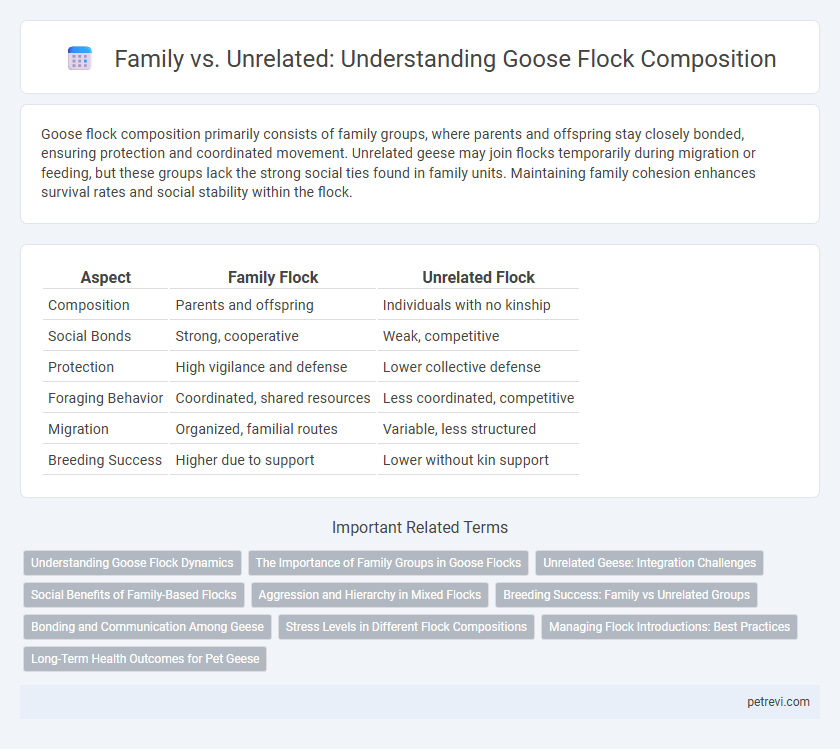Goose flock composition primarily consists of family groups, where parents and offspring stay closely bonded, ensuring protection and coordinated movement. Unrelated geese may join flocks temporarily during migration or feeding, but these groups lack the strong social ties found in family units. Maintaining family cohesion enhances survival rates and social stability within the flock.
Table of Comparison
| Aspect | Family Flock | Unrelated Flock |
|---|---|---|
| Composition | Parents and offspring | Individuals with no kinship |
| Social Bonds | Strong, cooperative | Weak, competitive |
| Protection | High vigilance and defense | Lower collective defense |
| Foraging Behavior | Coordinated, shared resources | Less coordinated, competitive |
| Migration | Organized, familial routes | Variable, less structured |
| Breeding Success | Higher due to support | Lower without kin support |
Understanding Goose Flock Dynamics
Goose flock composition varies significantly between family groups and unrelated individuals, influencing social cohesion and communication patterns within the flock. Family units typically exhibit stronger bonds and coordinated movements, enhancing predator vigilance and foraging efficiency. Understanding these dynamics helps in predicting flock behavior and managing habitats to support healthy goose populations.
The Importance of Family Groups in Goose Flocks
Family groups in goose flocks play a crucial role in maintaining social cohesion and enhancing survival rates, as goslings benefit from parental protection and guidance. These kin-based groups facilitate cooperative behaviors, such as coordinated flight and collective vigilance against predators, improving overall flock stability. Flocks composed primarily of related individuals exhibit stronger social bonds and more effective communication, which increases foraging efficiency and reproductive success.
Unrelated Geese: Integration Challenges
Unrelated geese in a flock face significant integration challenges, including increased aggression and competition for resources compared to family groups. These dynamics often lead to unstable social hierarchies and frequent conflicts, disrupting flock cohesion. Successful integration requires adaptive behaviors such as increased vigilance and social bonding efforts to mitigate tensions.
Social Benefits of Family-Based Flocks
Family-based goose flocks exhibit stronger social cohesion and cooperative behaviors that enhance survival and foraging efficiency. These flocks benefit from established kinship bonds that reduce conflict and improve collective vigilance against predators. Maintaining family groups promotes successful rearing of offspring and increases overall reproductive fitness in geese populations.
Aggression and Hierarchy in Mixed Flocks
Goose flocks composed of family members exhibit lower aggression levels and more stable hierarchies compared to mixed flocks of unrelated individuals. Kin-based groups maintain clear social ranks through established bonds, reducing conflicts and fostering cooperation. In contrast, unrelated geese frequently engage in aggressive encounters to establish dominance, leading to more fluid and unstable hierarchy structures.
Breeding Success: Family vs Unrelated Groups
Goose flock composition significantly influences breeding success, with family groups demonstrating higher reproductive outcomes compared to unrelated groups. Studies show that family flocks benefit from coordinated defense and cooperative care, leading to increased gosling survival rates. In contrast, unrelated groups often experience heightened aggression and less coordinated parental investment, reducing overall breeding success.
Bonding and Communication Among Geese
Family groups in goose flocks exhibit stronger bonding and more synchronized communication through honking patterns and body language compared to unrelated individuals. These familial bonds enhance cooperative behaviors such as coordinated foraging and vigilant predator detection. Unrelated geese show less cohesive interactions and reduced signal clarity, impacting group unity and response efficiency.
Stress Levels in Different Flock Compositions
Goose flocks composed primarily of family groups exhibit significantly lower stress levels compared to mixed, unrelated flock compositions, as measured by cortisol concentrations and behavioral indicators such as preening and vocalization rates. Cohesive family units provide social stability and reduce aggressive encounters, promoting overall flock health and well-being. In contrast, unrelated flocks experience heightened vigilance and conflict, leading to elevated stress and potentially reduced reproductive success.
Managing Flock Introductions: Best Practices
Managing flock introductions among geese requires careful consideration of family versus unrelated birds to maintain harmony and reduce aggression. Introducing goslings or related family members first helps establish social bonds and hierarchy more smoothly than mixing unrelated adults abruptly. Gradual, supervised introductions with visual barriers reduce stress and allow geese to acclimate, promoting a cohesive and stable flock dynamic.
Long-Term Health Outcomes for Pet Geese
Goose flock composition significantly impacts the long-term health outcomes of pet geese, with family groups providing better social stability and stress reduction compared to unrelated flocks. Family units encourage natural behaviors, enhancing immune function and reducing susceptibility to disease. Unrelated geese often exhibit increased aggression and competition, leading to higher stress levels and potential chronic health issues.
Family vs Unrelated for Goose Flock Composition Infographic

 petrevi.com
petrevi.com